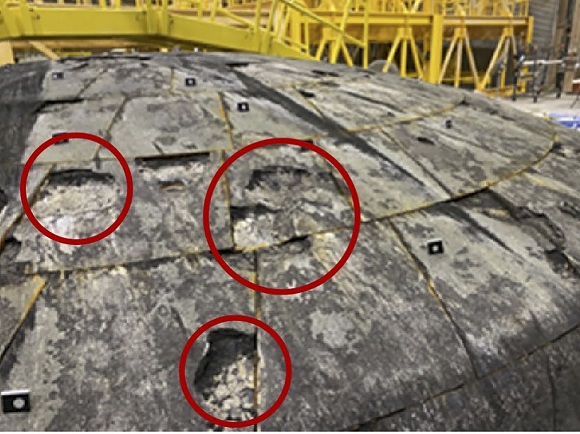science news online news
By Richard Tribou
Orlando Sentinel
(Orlando Sentinel) The damage to the Orion capsule from the Artemis I mission is already top of mind for NASA as it works to make the Artemis II mission safe for humans. But a new agency report revealed the extent of the problem, including scores of cracks in Orion’s critical heat shield.
The report from NASA’s Office of Inspector General outlined six issues that need NASA’s attention, with the heat shield damage found after the uncrewed Artemis I test mission in late 2022 at the top of the list.
NASA found more than 100 places on the heat shield where what’s known as the char layer ended up “cracking and breaking off the spacecraft in fragments that created a trail of debris rather than melting away as designed,” the report reads. Images released for the first time in the report showed the extent of the damage.
It notes that the reentry speeds coming in from a lunar trajectory reach nearly 25,000 mph, which is about 40% faster than what astronauts face when returning from low-Earth orbit in SpaceX’s Crew Dragon. The heat shield has to endure temperatures close to 5,000 degrees Fahrenheit.
science news online news
“While there was no evidence of impact with the crew module, the quantity and size of the debris could have caused enough structural damage to cause one of Orion’s parachutes to fail,” the report reads. “Should the same issue occur on future Artemis missions, it could lead to the loss of the vehicle or crew.”
“Given the high stakes of the first crewed flight, the agency is working to identify and mitigate any risks and challenges to ensure the safe return of the Artemis II crew and safeguard NASA’s significant investment in Artemis vehicles and systems,” the report reads.
Artemis II is set to be the first crewed mission of Orion, which will launch atop the Space Launch System rocket targeting liftoff from Kennedy Space Center’s Launch Pad 39-B no earlier than September 2025. The test flight with four astronauts will travel to the moon and back without landing. The goal is to show it can fly safely with humans on board.
The report was released on May 1 by independent investigators of NASA missions as a watchdog for mission dangers and cost realities. It states that by the time Artemis II launches, NASA will have spent more than $55 billion on the SLS, Orion, and Exploration Ground Systems programs that include the mobile launcher based at KSC.
The report specifically recommends NASA “ensure the root cause of Orion heat shield char liberation is well understood prior to [the] launch of the Artemis II mission.”
science news online news
NASA leaders say they are committed to fixing the heat shield but have admitted they might not be able to nail down the root cause for the damage. The report warned that NASA’s plan to consider modifying Orion’s reentry trajectory or redesigning the heat shield can also introduce unknown risks.
The second recommendation is to analyze further NASA’s planned changes to Orion’s separation bolts that connected the crew module to the service module. The service module gets discarded right before reentry, and NASA found “unexpected melting and erosion that created a gap leading to increased heating inside the bolt during Orion’s reentry.”

The third has to do with damage to the mobile launcher when the Space Launch System rocket took off from Kennedy Space Center, calling on NASA’s Exploration Ground Systems to “conduct additional verification and validation for launch imagery equipment prior to launch attempts.”
The final three recommendations were to reexamine its procedures on landing recovery operations to increase chances it doesn’t lose jettisoned hardware including the parachutes, which for Artemis I sank into the ocean; to address bad telemetry data it saw on that flight; and the make sure any design changes fit into a timeline for the upcoming stacking operations of SLS and Orion at KSC’s Vehicle Assembly Building.
science news online news
It credits NASA for working to address all of the issues already. In NASA’s response, it said it had already completed plans for the last three recommendations. NASA expects to conclude plans for both its heat shield and bolt fixes by June and to have its mobile launcher changes in place by September.
The report, though, warns that plans on how to fix Orion’s issues could force more delays and cost increases, such as the risk of having to slow down the rocket and spacecraft stacking operations at the VAB.
“Human space flight by its very nature is inherently risky, and the Artemis campaign is no exception,” the report says. “We urge NASA leadership to continue balancing the achievement of its mission objectives and schedule with prioritizing the safety of its astronauts and to take the time needed to avoid any undue risk.”
Already Artemis II was pushed from a planned November launch this year to no earlier than September 2025. Flying on the mission are NASA astronauts Reid Wiseman, Victor Glover and Christina Koch along with Canadian astronaut Jeremy Hansen.
Glover for one is happy to have extra eyes on such a complicated mission.
“I love the watchdogs. I love that we have this thing called inspector generals,” he said last weekend while at KSC ahead of the Boeing Starliner launch attempt.
science news online news
The report “has injected some new energy in this, but we’ve been following it since they found it,” Glover said. “The issues with Artemis I, we’ve been watching it since before we were assigned to Artemis II. So I have trust in that team. The folks running that investigation know what they’re doing. We have a lot of work left to do though.”
Suggesting that would include not having a heat shield pocked with fist-size holes, Glover responded, “Amen.”
He praised NASA’s new Moon to Mars Program Office, created in early 2023, to bring together all of the various players of the Artemis program including major contractors Boeing, Lockheed Martin, Northrop Grumman, SpaceX and Axiom Space so everyone buys into the same timeline.
Its creation only months before Artemis II was supposed to launch, raised Glover’s alarm, noting the Columbia Accident Investigation Board report discusses the dangers of making organizational changes close to a mission.
And while the new program consolidated redundancies so that the mission objectives are very clear, “it’s still something for us to be aware of, where we’re tiptoeing into areas that before have caused us tragedy.”
Changing lines of authority that close to the mission comes with risk, he said.
“We’re a new team. People have to learn to be open and transparent,” he said. “It is not people’s natural state to just be like, ‘Hey, let me tell you what I’ve messed up today.’ And now they’ve got a new boss, like, ‘I just got comfortable telling the old boss.’”
The push in the launch date to 2025 isn’t a delay, Glover said, but merely a correction.
“I’m not beholden to those dates. I’m beholden to Dionna, Genesis, Maya, Joia and Corinne, and Nala. That’s my family and my dog,” he said. “And yeah, I work for Bill Nelson, but at the end of the day, we work for the people. … So sorry to be crass, but I give a damn about that date.”
©2024 Orlando Sentinel. Visit at orlandosentinel.com. Distributed by Tribune Content Agency, LLC.
science news online news


